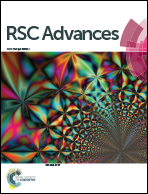Stability study of organometal halide perovskite and its enhanced X-ray scintillation from the incorporation of anodic TiO2 nanotubes†
Abstract
Organometal halide perovskite-based optoelectronic devices are currently a hot research area owing to their unique properties, but widespread commercialization is plagued by their poor long-term stability. So far, the degradation mechanism of organometal halide perovskites is still indistinct due to limited real time systematic study. In this work, we in situ study the crystal evolution of an organometal halide perovskite CH3NH3PbI3, which is prepared on different kinds of framework substrates. Based on the in situ grazing incidence X-ray diffraction and X-ray near absorption edge spectrum, we observe the formation of some 2D networks of [PbI6]4− octahedra intermediates during CH3NH3PbI3 degradation in a moist environment at the early step of the degradation mechanism. We also show that the structural stability of CH3NH3PbI3 deposited anodic TiO2 nanotube substrates is relatively better than that of prepared perovskite on TiO2 nanoparticles in moisture. The confinement of the 3D [PbI6]4− octahedral crystal network probability reduces the ion migration by regular pores of crystalline TiO2 nanotubes, improving the stability of the organometal halide perovskite. Furthermore, the X-ray excited luminescence intensity of CH3NH3PbI3 fabricated on TiO2 nanotubes is boosted 88% compared with that of conventional TiO2 nanoparticle substrates, which demonstrates its potential application in scintillation detectors.



 Please wait while we load your content...
Please wait while we load your content...